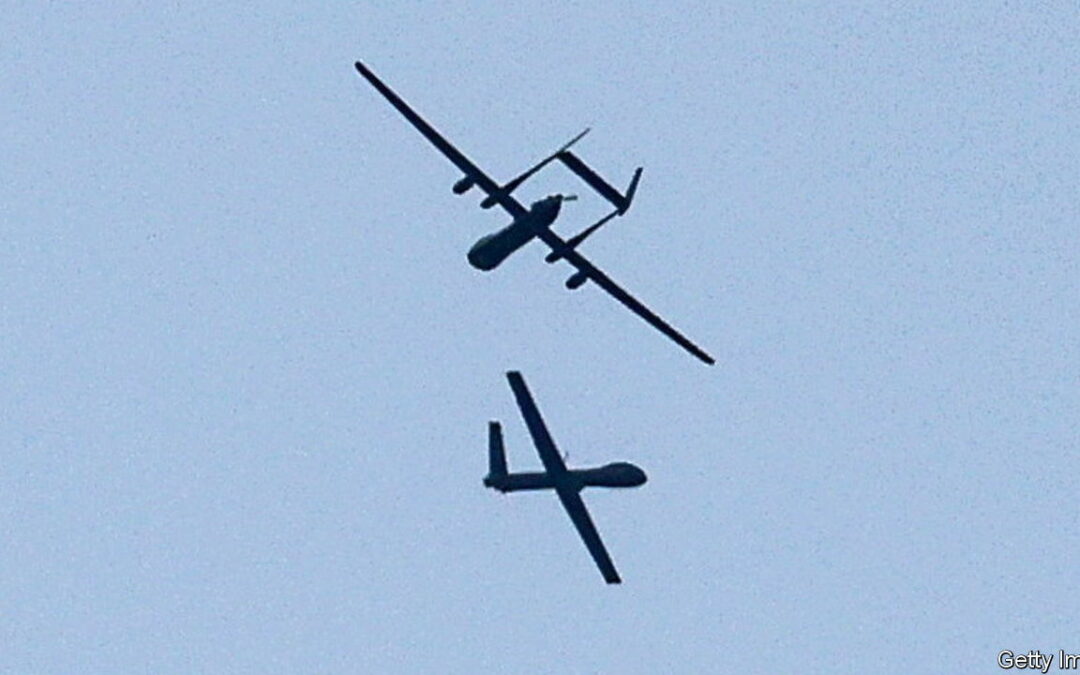THE GAZA STRIP is a risky place for an invading army: its cities provide cover for Hamas fighters, who know the terrain; it is heavily populated, with civilians often in harm’s way; fighting in built-up areas is likely to be at close quarters and consequently bloody. Since the outbreak of war between Israel and Hamas, some 75 Israeli soldiers have been killed in Gaza (more than 300 other military personnel died in the terrorist attack on October 7th). Israel has used aerial and artillery bombardment to pummel Hamas from a safe distance: more than 15,500 Palestinians, according to Gaza’s Hamas-run health ministry. When troops engage, Israeli commanders have other means to reduce the risk to their soldiers, by putting drones on the front lines. What role are drones playing in this war—and what risks do they pose to civilians?
Drones are becoming an ever more important tool of war. In Ukraine, where they act as scouts and kamikaze bombers, cheap expendable models have become essential for infantry operations by both sides. The challenges in Gaza are different: most of the fighting in Ukraine has been in open terrain, not urban areas. But Israel has long been at the forefront of military-drone use, says Zachary Kallenborn, of the Centre for Strategic and International Studies, a think-tank in Washington. In 1982, during the first Lebanon war, Israel Defence Forces (IDF) drones drew anti-aircraft-missile fire and located missile sites. By 1989 Israel had developed its first attack drone. In 2017 the Centre for a New American Security, another Washington-based think-tank, estimated that 60% of international exports of military drones over the previous three decades had come from the country. Like Ukraine it has a nimble tech industry, which has helped it to stay at the cutting edge.
Now Israel’s home-grown expertise is being put to use in Gaza. Israel and America are both using large high-flying drones to carry out constant surveillance of the strip. But Israel is also deploying smaller drones that can get much closer to the action. (Hamas also used small drones in its initial assault to destroy cameras and attack IDF troops.) The IDF is not releasing details of its operations but Aviv Shapira and Rubi Liani, co-founders of Xtend, an Israeli drone startup, told The Economist that their models are being used in Gaza. One, Xtender, is a small drone designed for indoor and underground operations, making it well suited to buildings and tunnels in places such as Gaza city. The drone has shrouded rotors to prevent damage from contact with walls and its software allows it to recognise objects and avoid collisions. It can attach a charge strong enough to break down a door, back away before it is detonated and then proceed. Xtender can also carry a small explosive warhead, weighing up to 150 grams.
Wolverine, a larger drone, can manage over ten times that. It is big enough to carry through-the-wall life-detection radar to check whether a building is occupied, or a gripping claw for picking up objects. These drones are often used to inspect possible explosives, and blow them up from a safe distance or create a diversion with a stun grenade while troops approach.
Israel’s drones are advanced, but Gaza presents special difficulties. As Mr Shapira notes, the first thing drones lose in urban combat is GPS, which stops working indoors and in “urban canyons” where tall buildings block signals from satellites. Drones operating in these conditions use Simultaneous Localisation and Mapping, an alternative system: their cameras build a 3D model of their environment and track their location.
Radio links, used for communication, are also weaker indoors and underground; and Hamas is thought to be jamming both GPS and radio signals. One way of overcoming these obstacles is to have drones act as communication relays for other drones; Xtenders can work in a chain to connect an operator with a unit which would otherwise be out of reach. These drones can also operate semi-autonomously, continuing with a mission without human input or returning to a place where they can connect via radio. That they can function autonomously also makes these drones easier for operators to use, enabling them to focus on important updates, such as whether the drone has found people or weapons.
Drones are intended to reduce the danger to soldiers, but they also have a devastating impact on civilians. Operators can and do make mistakes and to send explosive-laden drones into buildings where civilians are sheltering brings obvious dangers. And although Xtend is keen to point out that it does not build autonomous “killer robots” able to locate, identify and attack targets on their own, the technology to do just that is now feasible. For better or worse, there is now nowhere drones cannot reach.■









